
Wine Culture and Information since 2002 - Volume 22
 Wine Culture and Information since 2002 - Volume 22 |
|
Issue 158, January 2017 |
Contents |
|
|
The Art of Wine |
|
Wine is art. I have no doubts about this. From the moment wine appeared in the history of human beings, or better to say, of what we know about our past, it is evident it always played a role of primary importance. Wine, just like art, has always been capable of arousing emotions and sentiments while becoming, virtually from the very moment of its “birth”, important element of cultures, pagan and religious rites. Wine has the capability - like to say - of joining the sacred to profane, by becoming the central beverage of bacchanals and joyous moments, as well as a fundamental element in the solemnity of some religious rites. Wine is also an element identifying people and their lands, as well as becoming the subject of ideological clashes and supposed superiority. An aspect, this latter one, still alive today and going far beyond the simple evaluation based on matters of taste only. Wine, moreover, becomes art. From the moment in which it is given life to a new vineyard and the vines are being planted to the moment in which wine is poured on a glass. Walking down the vineyard, you in fact realize the art revealing in the rows, not only expression of vines and what Nature teaches them, but also of how men interpret them. Walking down a producer's vineyard - something clearly more interesting than the view of casks, barrels and tanks - gives the chance to understand the relationship that producer has with wine. His or her wine, of course. Because it is how the vintner takes care of the vineyard you understand what wine he or she will make from those grapes. It is not about a matter of “order”, something you would see in an ornamental garden - after all, even chaos is capable of expressing art - indeed it is about how the vines grow up and express their grapes. However, there is no doubt about this, a certain order in the vineyard is needed according to the type of wine to be produced. This too is art. Wine is also technique, a word that - apparently - seems to have no connection to art. Technique is however art, something confirmed even by its etymological meaning, as this word comes from Greek τέχνη (téchne), which meaning is art, strongly associated to the capability of “knowing how”. The capability of knowing how to do something is indispensable to the concrete expression of art as, without this, it is not possible to achieve the fundamental process of transformation into an element which can be shared with others. Wine is no exception to this condition, as wine is made and it is made by men who interpret, according to their own art, what they cultivate in the vineyard and transform in the cellar. Just like a painter who transforms colors through art, therefore creating a painting expressed through brushes and canvas, the same is for the vintner who transforms grapes according to his or her own art. There is not a unique form of art only - as it can be clearly expressed in endless forms and cultures - and the same is true for wine, as it is not something expressed according to a unique method or way. Another element common both to art and wine is the property of arousing passion in persons, sometimes with lively debates conducted by supporters in their respective sides. The same is clearly happening with other artistic expressions, such as music, painting, photography and cooking. There are some who love wine exclusively produced according to certain techniques or school of thoughts, others love something different and, in both cases, they deny and disregard the expression opposite to their taste. The same is happening for those who support a certain musical band, who likes that and only that, while criticizing the other ones which are seen as a sort of negation to their taste or musical preference. It is undeniable they both are art, expression of the human genius who conceived, expressed and interpreted it. The charm of wine in human beings is incredibly vast and noble. I do not think it is because of alcohol, although I understand history gave us and keep on giving us tangible proofs about the relationship, even at a sacred and ritual level, human beings have with alcoholic beverages. To tell the truth, it should be said alcoholic beverages have been used - even today - to cause a supposed ecstatic condition capable of connecting man, or the ministries of certain cults, to gods and to favor communication. The case of wine is however singular. If we consider an alcoholic beverage can be obtained from the simple fermentation of any substance containing sugar - therefore not only grape juice - it is evident wine has a special dignity. A strong element of traditional and cultural identification, wine has been successful in making people living in distant lands to dream. Not to mention the many praises about the wines of the past and of which we can read in very ancient documents, such those, for example, written by Pliny the Elder, Horace, Martial, Columella and Varro. What we then should say about wine in the art? The noble beverage of Bacchus has frequently been subject or complement in countless paintings, not to mention poetry, prose and music. If it is true art is realized through senses - those of the one who is expressing it, those of the ones who are perceiving it - it is evident sensorial tasting too is art, that is the art of interpreting art. It should be said the art of wine would not exist without the essential contribution of territory and land, last but not the least, man who uses these elements as a hypothetical palette used to paint a wine. Every element is equally essential, likewise it is fundamental the use one makes of the single elements in order to combine them into a finished work, an interpretation which cannot necessarily have a unique vision. As opposed to tangible and repeatable art, wine art can be enjoyed just once and not by all. After having poured it in a glass, in fact, a wine gives his memory only to those who have been capable of enjoying it. Who would have ever said this? Much ado about “simple” fermented grape juice? Antonello Biancalana
|
||||
Contrasts of Cabernet Franc and TeroldegoThe main glory of autochthonous red grapes of Trentino compared by contrast to Cabernet Franc, one of the celebrities of French viticulture |
|
The tasting of two wines very different one from each other offers interesting chances of study. Most of the times, differences, even substantial ones, make the respective characteristics to be better understood just because they are distant qualities. This is the case of the grapes of this month's tasting by contrast, varieties being so different one from each other in every sensorial aspect. Teroldego and Cabernet Franc are in fact the protagonists of our tasting by contrast, revealing - in their respective glasses - different qualities as well as strong personalities. Cabernet Franc is mainly known for its sensorial profile characterized by evident aromas recalling the world of vegetables, in particular green bell pepper. Teroldego can be appreciated for its aromas directly recalling black berried fruits such as black cherry and blackberry. The sensations recalling fruits are also found in Cabernet Franc, however this famous variety from Bordeaux is mainly known and appreciated for its herbaceous profile. Both varieties can be used for the production of wines having strong personalities and by using different wine making techniques. Cabernet Franc and Teroldego give excellent results both when vinified in inert container and in wood containers, such as cask or barrique. The two varieties are also used for the making of wines blended to other grapes, in particular Cabernet Franc which is frequently blended to Cabernet Sauvignon and Merlot to make the world famous Bordeaux blend. Teroldego, although it is also used with other varieties, is mainly vinified alone for the making of mono-varietal wines, however it is well perceptible even in case it is blended to other grapes. The two varieties have in fact a strong expressive character such to make them easily recognizable in wines in which are blended to other grapes.
|
|
Cabernet Franc is a variety capable of making wines of remarkable elegance and with a good structure. Famous for being one of the varieties making the so called Bordeaux blend, it originated in France and precisely in French Basque Country, in the area of Pyrénées-Atlantiques. It became famous in the 1600s with red wines of Loire Valley, area in which this variety is still found and used. Cabernet Franc was introduced in the Bordeaux area, in the Libournais region, in 1700s by Cardinal Richelieu. Frequently confused with Cabernet Sauvignon and, in particular in Italy, with Carménère, this variety makes wines of good structure and with an appreciable crispness. Research done about DNA, have found out Cabernet Franc, from the spontaneous crossing with Sauvignon Blanc, originated Cabernet Sauvignon, a variety known for its full bodied and powerful wines. One of the characteristics literally dividing wine lovers is the tendency of Cabernet Franc to make wines with a remarkable herbaceous profile, in which can be easily perceived the aromas of green bell pepper. It should be said this characteristic - appreciated by many, not liked at all by others - is strongly connected both to the territory and grape's ripeness. The typical green bell pepper aroma is in fact perceived in wines made with non perfectly ripe grapes as well as for a specific choice of the producer, including particular meteorological conditions. When it reaches a perfect ripeness, and provided the right quality criteria, the herbaceous aromas of Cabernet Franc are strongly attenuated, even becoming absent in certain cases. Wines of moderate body and pleasing crispness, they are successfully aged in wood containers, a procedure increasing the aromatic complexity of Cabernet Franc. The character of this variety does not pass unnoticed and it can be easily perceived when found, even in small quantity, in blended wines.
|
||||
|
Variety of ancient origins, Teroldego is the glory of the red wines of Trentino. The origin of this grape's name is still today subject of debates. For some it originated from Tiroler Gold, that is “gold or Tyrol”, as it seems this is how they used to call it in courts of Vienna because of the appreciation they had for wines produced with this grape. This theory supports Teroldego originates from the lands in the border of Tyrol, called with many names and all having the same meaning. Tiroldigo, Tiroldela, Tiraldela and Tiroldegho, are names used in the past to call this variety. For others the origin of Teroldego is to be found in the territory of Garda Lake in the Verona area and specifically to the grape they called Tirodola. The name seems to take its origin from the viticultural technique used with this vine, by using “live supports” called tirelle. Recent research done on the genetics of this variety have found out analogies with Lagrein, Marzemino and Syrah grapes, which origins are from the Middle-East. Teroldego is particularly common in the Piana Rotaliana, the territory found in the northern area of Trentino near the border with Alto Adige (South Tyrol), where this grape is the protagonist of DOC wines belonging to the Teroldego Rotaliano appellation. The famous red from Trentino is a quite versatile variety and it is well suited both to the production in inert containers and in cask, giving wines having a quite different character. Teroldego can make wines suited for a long aging, giving organoleptic profiles of interesting complexity. Characterized by a good structure, wines produced with this grape can be pretty round while expressing, at the same time, a pleasing crispness. It should also be noticed Teroldego is a variety particularly suited for the production of wines made with the carbonic maceration technique - the so called nouveau wines - in which the strong fruit character of the grape becomes very intense and pleasing.
|
|
Choosing wines produced with Cabernet Franc and Teroldego is easy thanks to their vast production. We will however make sure they are really produced with the two varieties alone. This is particularly true for Cabernet Franc, as it is frequently used blended to other grapes, in particular Cabernet Sauvignon and Merlot. We will also pay attention on the confusion existing in Italy, where Cabernet Franc is sometimes confused with Carménère. We will also make sure to not choosing a wine generically labeled as Cabernet because they are a blend of Cabernet Sauvignon and Cabernet Franc. For our tasting by contrast we will choose a Teroldego Rotaliano, possibly aged in inert containers. As for Cabernet Franc we will choose a wine from the vast production of Friuli Venezia Giulia, in particular Colli Orientali del Friuli DOC. Both wines must not be older than two years, a fundamental characteristic in order to better appreciate the herbaceous character of Cabernet Franc. The two wines will be served at the temperature of 18 °C (65 °F) in tasting glasses.
Let's pour the two wines in their respective glasses and start our tasting by contrast from the appearance analysis of Colli Orientali del Friuli Cabernet Franc. The color of this wine - observed at the base of the glass - shows an intense ruby red hue and a moderate transparency. Let's now tilt the glass on a white surface - such as, for example, a sheet of paper - and observe the nuance of wine towards the opening of the glass. We see an intense ruby red that, sometimes, can show hints of purple red. Let's now pass to the analysis of Teroldego Rotaliano, by observing the base of the glass. The color of the wine from Trentino shows an intense ruby red hue and a lower transparency than Cabernet Franc. Let's tilt the glass and observe Teroldego's nuances: we will see, once again, a ruby red color with evident purple hints, a confirmation of the good coloring property of this grape. Let's now continue our tasting by contrast with the olfactory profile of Cabernet Franc and Teroldego. Like already said, they are two very different varieties and, in particular, the aromas they express from the glass. Cabernet Franc is famous for its profile having a strong herbaceous character, in which are frequently perceived aromas of green bell pepper, tomato leaf and fresh cut grass. This characteristic is frequently found in young Cabernet Franc wines and - in particular - when the grapes come from territories having a cold climate or when they did not reach full ripeness. With time, in fact, the herbaceous characteristic of the French red is strongly attenuated. Cabernet Franc, of course, is not the expression of herbaceous aromas only: in this grape can also be perceived black berried fruits such as black currant, black cherry, blueberry and plum. Teroldego gives the nose a character clearly oriented to red and black fruits, in particular black cherry, plum and blackberry. Let's proceed with the olfactory evaluation of the wines of our tasting by contrast from Colli Orientali del Friuli Cabernet Franc. The first smell, allowing us to asses the opening of wine, immediately expresses the herbaceous character of this variety. It is in fact perceived the typical aroma of bell pepper as well as the sensations of black cherry, black currant and blueberry. Let's swirl the glass, this will favor the development of other aromas, and do a second smell. The profile of Cabernet Franc is completed by violet, plum and, sometimes, tomato leaf. Let's now pass to the glass of Teroldego Rotaliano and proceed with the first smell. The opening of the red from Trentino is characterized by clean aromas of black cherry, blackberry and plum as well as violet. After having swirled the glass and proceeded with the second smell, the wine completes its profile with raspberry and, sometimes, strawberry and pomegranate. We should now compare the olfactory profile of both wines: the herbaceous character of Cabernet Franc is now more evident thanks to the comparison by contrast. The differences between the two wines are evident also during the phase of gustatory analysis. Let's take a sip of Colli Orientali del Friuli Cabernet Franc and evaluate its attack, that is the first sensations the wine gives to the mouth. We will perceive a character of moderate astringency and a good structure, well supported by a pleasing crispness balanced by the effect of alcohol. The correspondence to the nose is good: the flavors of black cherry, black currant and blueberry are clearly perceptible in the mouth. Let's now pass to the evaluation of Teroldego Rotaliano's opening and take a sip of this wine. The attack of the red from Trentino is characterized by a good structure and proper astringency and, as opposed to the previous wine, we can perceive a rounder sensation and a lesser crispness. In the mouth are clearly perceived the flavors of black cherry, blackberry and plum, therefore confirming a good correspondence to the nose. The last phase of our tasting by contrast analyzes the final sensations the wines leave in the mouth, in particular taste-olfactory persistence, one of the main factors determining quality. The finish of Colli Orientali del Friuli Cabernet Franc is characterized by a good taste-olfactory persistence, leaving in the mouth pleasing flavors of black currant, black cherry and blueberry. Besides this, we will continue perceiving the pleasing sensation of crispness given by the moderate acidity of wine. The finish of Teroldego Rotaliano is persistent as well and in the mouth are perceived pleasing flavors of black cherry, blackberry and plum, as well as a sensation of roundness and a fuller body than the previous wine. Finally, let's compare the other gustatory sensations the two wines leave in the mouth, in particular the herbaceous character of Cabernet Franc, a quality perceived in the mouth as well, something not found in Teroldego.
|
||||||||
Wines of the Month |
|
|
|
Score legend Prices are to be considered as indicative. Prices may vary according to the country or the shop where wines are bought |

|
|
Trento Extra Brut Perlé Nero 2008 |
|
| Ferrari (Trentino, Italy) | |
 Pinot Nero Pinot Nero | |
| Price: € 55.00 | Score: |
 Intense golden yellow and nuances of golden yellow, very transparent,
fine and persistent perlage. Intense golden yellow and nuances of golden yellow, very transparent,
fine and persistent perlage.
 Intense, clean, pleasing, refined and elegant, starts with hints of
apple, plum and bread crust followed by aromas of pear, pineapple,
hazelnut, grapefruit, butter, yeast, hawthorn, honey and mineral. Intense, clean, pleasing, refined and elegant, starts with hints of
apple, plum and bread crust followed by aromas of pear, pineapple,
hazelnut, grapefruit, butter, yeast, hawthorn, honey and mineral.
 Crisp and effervescent attack, however balanced by alcohol, good body,
intense flavors, agreeable. Crisp and effervescent attack, however balanced by alcohol, good body,
intense flavors, agreeable.
 Very persistent finish with long flavors of apple, plum and grapefruit. Very persistent finish with long flavors of apple, plum and grapefruit. Refermented in bottle and aged on its lees for at least 6 years. Refermented in bottle and aged on its lees for at least 6 years. |
|
 Roasted white meat, Roasted fish, Stewed fish, Stuffed pasta Roasted white meat, Roasted fish, Stewed fish, Stuffed pasta |
|
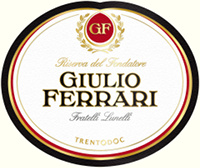
|
|
Trento Extra Brut Giulio Ferrari Riserva del Fondatore 2004 |
|
| Ferrari (Trentino, Italy) | |
 Chardonnay Chardonnay | |
| Price: € 82.00 | Score: |
 Intense golden yellow and nuances of golden yellow, very transparent,
fine and persistent perlage. Intense golden yellow and nuances of golden yellow, very transparent,
fine and persistent perlage.
 Intense, clean, pleasing, refined and elegant, starts with hints of
apple, bread crust and plum followed by aromas of citrus fruits, banana,
acacia, honey, candied fruits, butter, beeswax, yeast, white chocolate,
rosemary, thyme and mineral. Intense, clean, pleasing, refined and elegant, starts with hints of
apple, bread crust and plum followed by aromas of citrus fruits, banana,
acacia, honey, candied fruits, butter, beeswax, yeast, white chocolate,
rosemary, thyme and mineral.
 Effervescent and crisp attack, however balanced by alcohol, good body,
intense flavors, pleasing roundness. Effervescent and crisp attack, however balanced by alcohol, good body,
intense flavors, pleasing roundness.
 Very persistent with long flavors of apple, plum and banana. Very persistent with long flavors of apple, plum and banana. Refermented and aged in bottle on its lees for 10 years. Refermented and aged in bottle on its lees for 10 years. |
|
 Roasted white meat, Roasted fish, Fish soups, Stuffed pasta Roasted white meat, Roasted fish, Fish soups, Stuffed pasta |
|
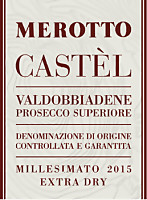
|
|
Valdobbiadene Prosecco Superiore Extra Dry Castèl 2015 |
|
| Merotto (Veneto, Italy) | |
 Glera Glera | |
| Price: € 17.00 | Score: |
 Brilliant greenish yellow and nuances of greenish yellow, very
transparent, fine and persistent perlage. Brilliant greenish yellow and nuances of greenish yellow, very
transparent, fine and persistent perlage.
 Intense, clean, pleasing and refined, starts with hints of pear,
wisteria and apple followed by aromas of peach, plum, broom, pineapple,
acacia and tangerine. Intense, clean, pleasing and refined, starts with hints of pear,
wisteria and apple followed by aromas of peach, plum, broom, pineapple,
acacia and tangerine.
 Effervescent and crisp attack, however balanced by alcohol, good body,
intense flavors, pleasing hist of sweetness. Effervescent and crisp attack, however balanced by alcohol, good body,
intense flavors, pleasing hist of sweetness.
 Persistent finish with flavors of pear, peach and apple. Persistent finish with flavors of pear, peach and apple. Fermented in closed tank for 50 days, aged on its lees for 4 months. Fermented in closed tank for 50 days, aged on its lees for 4 months. |
|
 Aperitifs, Vegetable and crustacean appetizers, Risotto with vegetables, Sauteed crustaceans Aperitifs, Vegetable and crustacean appetizers, Risotto with vegetables, Sauteed crustaceans |
|
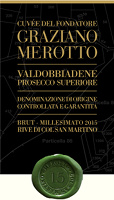
|
|
Valdobbiadene Prosecco Superiore Brut Rive di Col San Martino Cuvée del Fondatore Graziano Merotto 2015 |
|
| Merotto (Veneto, Italy) | |
 Glera Glera | |
| Price: € 18.00 | Score: |
 Intense greenish yellow and nuances of greenish yellow, very
transparent, fine and persistent perlage. Intense greenish yellow and nuances of greenish yellow, very
transparent, fine and persistent perlage.
 Intense, clean, pleasing, refined and elegant, starts with hints of
pear, wisteria and apple followed by aromas of hawthorn, pineapple, broom,
peach, kiwi, citrus fruits, plum and tangerine. Intense, clean, pleasing, refined and elegant, starts with hints of
pear, wisteria and apple followed by aromas of hawthorn, pineapple, broom,
peach, kiwi, citrus fruits, plum and tangerine.
 Effervescent and crisp attack, however balanced by alcohol, good body,
intense flavors, agreeable. Effervescent and crisp attack, however balanced by alcohol, good body,
intense flavors, agreeable.
 Persistent finish with flavors of apple, pear and peach. Persistent finish with flavors of apple, pear and peach. Fermented and aged in closed tanks for 6 months. Fermented and aged in closed tanks for 6 months. |
|
 Fish and crustacean appetizers, Sauteed crustaceans, Pasta and risotto with crustaceans Fish and crustacean appetizers, Sauteed crustaceans, Pasta and risotto with crustaceans |
|
|
|
|
Adarmando 2014 |
|
| Tabarrini (Umbria, Italy) | |
 Trebbiano Spoletino Trebbiano Spoletino | |
| Price: € 20.00 | Score: |
 Brilliant golden yellow and nuances of golden yellow, very
transparent. Brilliant golden yellow and nuances of golden yellow, very
transparent.
 Intense, clean, pleasing, refined and elegant, starts with hints of
apple, medlar and pear followed by aromas of citrus fruits, broom, lychee,
peach, hazelnut, pineapple, honey, hawthorn and mineral. Intense, clean, pleasing, refined and elegant, starts with hints of
apple, medlar and pear followed by aromas of citrus fruits, broom, lychee,
peach, hazelnut, pineapple, honey, hawthorn and mineral.
 Crisp attack and however balanced by alcohol, good body, intense
flavors, pleasing roundness. Crisp attack and however balanced by alcohol, good body, intense
flavors, pleasing roundness.
 Very persistent finish with long flavors of apple, medlar and lychee. Very persistent finish with long flavors of apple, medlar and lychee. At least 12 months in steel tanks, 6 months in bottle. At least 12 months in steel tanks, 6 months in bottle. |
|
 Pasta and risotto with mushrooms and crustaceans, Roasted white meat, Stewed fish Pasta and risotto with mushrooms and crustaceans, Roasted white meat, Stewed fish |
|

|
|
Montefalco Sagrantino Colle alle Macchie 2012 |
|
| Tabarrini (Umbria, Italy) | |
 Sagrantino Sagrantino | |
| Price: € 45.00 | Score: |
 Intense ruby red and nuances of garnet red, little transparency. Intense ruby red and nuances of garnet red, little transparency. Intense, clean, pleasing, refined and elegant, starts with hints of
blackberry, black cherry and violet followed by aromas of plum, blueberry,
pink pepper, tobacco, cocoa, vanilla, leather, mace, laurel and menthol. Intense, clean, pleasing, refined and elegant, starts with hints of
blackberry, black cherry and violet followed by aromas of plum, blueberry,
pink pepper, tobacco, cocoa, vanilla, leather, mace, laurel and menthol.
 Tannic attack and however balanced by alcohol, full body, intense
flavors, agreeable. Tannic attack and however balanced by alcohol, full body, intense
flavors, agreeable.
 Very persistent finish with long flavors of blackberry, black cherry
and plum. Very persistent finish with long flavors of blackberry, black cherry
and plum.
 36 months in cask, 12 months in bottle. 36 months in cask, 12 months in bottle. |
|
 Game, Braised and stewed meat, Roasted meat, Hard cheese Game, Braised and stewed meat, Roasted meat, Hard cheese |
|
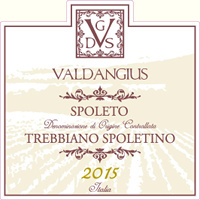
|
|
Spoleto Trebbiano Spoletino 2015 |
|
| Valdangius (Umbria, Italy) | |
 Trebbiano Spoletino Trebbiano Spoletino | |
| Price: € 11.00 | Score: |
 Intense golden yellow and nuances of golden yellow, very transparent. Intense golden yellow and nuances of golden yellow, very transparent. Intense, clean, pleasing and refined, starts with hints of apple, pear
and kiwi followed by aromas of hawthorn, citrus fruits, plum, broom,
medlar, lychee and mineral. Intense, clean, pleasing and refined, starts with hints of apple, pear
and kiwi followed by aromas of hawthorn, citrus fruits, plum, broom,
medlar, lychee and mineral.
 Crisp attack and however balanced by alcohol, good body, intense
flavors, pleasing roundness. Crisp attack and however balanced by alcohol, good body, intense
flavors, pleasing roundness.
 Persistent finish with flavors of apple, plum and kiwi. Persistent finish with flavors of apple, plum and kiwi. 7 months in steel tanks, 3 months in bottle. 7 months in steel tanks, 3 months in bottle. |
|
 Stuffed pasta with mushrooms, Roasted fish, Roasted white meat, Vegetable soups Stuffed pasta with mushrooms, Roasted fish, Roasted white meat, Vegetable soups |
|

|
|
Montefalco Sagrantino 2012 |
|
| Valdangius (Umbria, Italy) | |
 Sagrantino Sagrantino | |
| Price: € 23.00 | Score: |
 Intense ruby red and nuances of garnet red, little transparency. Intense ruby red and nuances of garnet red, little transparency. Intense, clean, pleasing and refined, starts with hints of blackberry,
plum and black cherry followed by aromas of dried violet, blueberry,
vanilla, chocolate, tobacco, leather and menthol. Intense, clean, pleasing and refined, starts with hints of blackberry,
plum and black cherry followed by aromas of dried violet, blueberry,
vanilla, chocolate, tobacco, leather and menthol.
 Tannic attack and however balanced by alcohol, full body, intense
flavors, agreeable. Tannic attack and however balanced by alcohol, full body, intense
flavors, agreeable.
 Persistent finish with flavors of blackberry, plum and black cherry. Persistent finish with flavors of blackberry, plum and black cherry. 12 months in barrique, 18 months in steel tanks, at least 6 months in
bottle. 12 months in barrique, 18 months in steel tanks, at least 6 months in
bottle.
|
|
 Game, Braised and stewed meat, Roasted meat, Hard cheese Game, Braised and stewed meat, Roasted meat, Hard cheese |
|
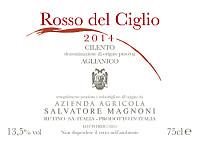
|
|
Cilento Aglianico Rosso del Ciglio 2014 |
|
| Salvatore Magnoni (Campania, Italy) | |
 Aglianico Aglianico | |
| Price: € 13.00 | Score: |
 Intense ruby red and nuances of ruby red, little transparency. Intense ruby red and nuances of ruby red, little transparency. Intense, clean, pleasing and refined, starts with hints of plum,
blackberry and black cherry followed by aromas of violet, blueberry,
vanilla, raspberry, cocoa, mace and menthol. Intense, clean, pleasing and refined, starts with hints of plum,
blackberry and black cherry followed by aromas of violet, blueberry,
vanilla, raspberry, cocoa, mace and menthol.
 Properly tannic attack and however balanced by alcohol, good body,
intense flavors, pleasing crispness. Properly tannic attack and however balanced by alcohol, good body,
intense flavors, pleasing crispness.
 Persistent finish with flavors of plum, blackberry and black cherry. Persistent finish with flavors of plum, blackberry and black cherry. 10 months in cask and barrique, 2 months and bottle. 10 months in cask and barrique, 2 months and bottle. |
|
 Stuffed pasta with meat, Stewed meat with mushrooms, Broiled meat and barbecue, Cheese Stuffed pasta with meat, Stewed meat with mushrooms, Broiled meat and barbecue, Cheese |
|
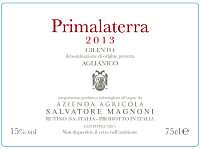
|
|
Cilento Aglianico Primalaterra 2013 |
|
| Salvatore Magnoni (Campania, Italy) | |
 Aglianico Aglianico | |
| Price: € 19.00 | Score: |
 Intense ruby red and nuances of garnet red, little transparency. Intense ruby red and nuances of garnet red, little transparency. Intense, clean, pleasing and refined, starts with hints of plum, black
cherry and blackberry followed by aromas of dried violet, blueberry,
leather, tobacco, vanilla, licorice and menthol. Intense, clean, pleasing and refined, starts with hints of plum, black
cherry and blackberry followed by aromas of dried violet, blueberry,
leather, tobacco, vanilla, licorice and menthol.
 Tannic attack and however balanced by alcohol, full body, intense
flavors, pleasing roundness. Tannic attack and however balanced by alcohol, full body, intense
flavors, pleasing roundness.
 Persistent finish with flavors of plum, black cherry and blackberry. Persistent finish with flavors of plum, black cherry and blackberry. 20 months in cask, 4 months in bottle. 20 months in cask, 4 months in bottle. |
|
 Game, Braised and stewed meat, Roasted meat, Hard cheese Game, Braised and stewed meat, Roasted meat, Hard cheese |
|

|
|
Barbaresco Pora 2013 |
|
| Musso (Piedmont, Italy) | |
 Nebbiolo Nebbiolo | |
| Price: € 20.00 | Score: |
 Brilliant ruby red and nuances of ruby red, moderate transparency. Brilliant ruby red and nuances of ruby red, moderate transparency. Intense, clean, pleasing and refined, starts with hints of cherry, plum
and violet followed by aromas of raspberry, strawberry, vanilla, rose,
tobacco, cinnamon and menthol. Intense, clean, pleasing and refined, starts with hints of cherry, plum
and violet followed by aromas of raspberry, strawberry, vanilla, rose,
tobacco, cinnamon and menthol.
 Tannic attack and however balanced by alcohol, full body, intense
flavors, pleasing crispness. Tannic attack and however balanced by alcohol, full body, intense
flavors, pleasing crispness.
 Persistent finish with flavors of cherry, plum and raspberry. Persistent finish with flavors of cherry, plum and raspberry. 24 months in cask, 8 months in bottle. 24 months in cask, 8 months in bottle. |
|
 Game, Roasted meat, Braised and stewed meat, Broiled meat and barbecue Game, Roasted meat, Braised and stewed meat, Broiled meat and barbecue |
|
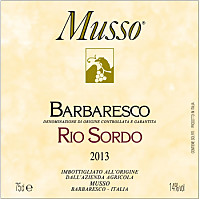
|
|
Barbaresco Rio Sordo 2013 |
|
| Musso (Piedmont, Italy) | |
 Nebbiolo Nebbiolo | |
| Price: € 20.00 | Score: |
 Brilliant ruby red and nuances of garnet red, moderate transparency. Brilliant ruby red and nuances of garnet red, moderate transparency. Intense, clean, pleasing, refined and elegant, starts with hints of
cherry, plum and violet followed by aromas of raspberry, strawberry, rose,
vanilla, pink pepper, tobacco, chocolate and cinnamon. Intense, clean, pleasing, refined and elegant, starts with hints of
cherry, plum and violet followed by aromas of raspberry, strawberry, rose,
vanilla, pink pepper, tobacco, chocolate and cinnamon.
 Tannic attack and however balanced by alcohol, full body, intense
flavors, pleasing crispness. Tannic attack and however balanced by alcohol, full body, intense
flavors, pleasing crispness.
 Persistent finish with flavors of cherry, plum and raspberry. Persistent finish with flavors of cherry, plum and raspberry. 18 months in cask, 8 months in bottle. 18 months in cask, 8 months in bottle. |
|
 Game, Braised and stewed meat, Roasted meat, Hard cheese Game, Braised and stewed meat, Roasted meat, Hard cheese |
|
News |
|
In this section are published news and information about events concerning the world of wine and food. Whoever is interested in publishing this kind of information can send us a mail to our address.
|
AquavitaeReview of Grappa, Distillates and Brandy |
|
|
||||||||||||||
Wine Guide ParadeOctober 2016
|
| |||||||
Privacy Policy | |||||||


| Copyright © 2002-2024 Antonello Biancalana, DiWineTaste - All rights reserved |
| All rights reserved under international copyright conventions. No part of this publication and of this WEB site may be
reproduced or utilized in any form or by any means, electronic or mechanical, without permission in writing from DiWineTaste. |